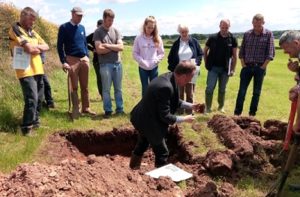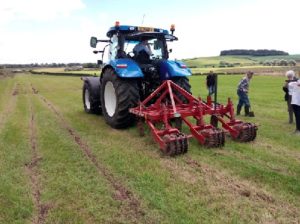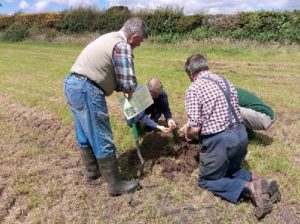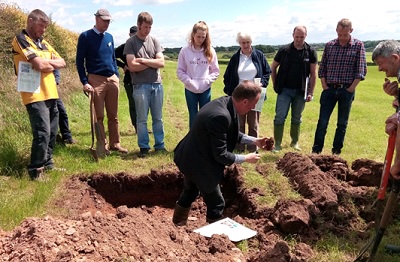Dumfries Soil & Nutrient Network – event summary
11 July 2017Valuing Your Soils
The meeting was held at Limekilns Farm, near Annan and was focused around the subject of soil management and application of lime.

Alastair Beattie (SAC Consulting Dumfries) provided the opening to the meeting and gave a brief introduction to the aims and objectives of the project and some background to Limekilns Farm.
The morning session included presentations and practicals from SRUC Soil Scientists Joanna Cloy, Bryan Griffiths and Grassland Specialist Paul Hargreaves on assessment of soil types and soil biology. After lunch, the group walked to a nearby field to observe field demonstrations of a sward slitter and a sward lifter and also investigated soil structure within the field using a trial pit
The event concluded with a presentation from SAC Consultant Donald Dunbar who provided an overview of how lime works and highlighted the merits of applying lime depending upon soil type and planned cropping.
Key Points
- The main threats to soils include: compaction, erosion, loss of organic matter.

- Use the visual assessment of areas of a field where there is concern about soil compaction to assess the severity and depth of the compaction. This will allow the correct management decision for the equipment to use: compaction at the surface (0 – 15cm) – slitter and deeper compaction (15 – 35cm) – sward lifter.
- Different crops have varying tolerance to low pH with cereals, oats and wheat being more tolerant than barley and grass being more tolerant than clover.
- When comparing liming products check the declared Neutralising Value (NV) as this indicates the speed and effectiveness of the liming material. Also check the declared particle sizes of the material, with fewer large particles being desirable.
- Compare the cost per unit of NV by dividing the cost per tonne (delivered and spread) by the NV of the product.
Information from guest speakers presentations and handouts from the delegate pack are available to download below. View photos from the event on our Facebook page.
The Dumfries-shire Soil & Nutrient Network group have produced a guide as to how to calculate the nutrient value of organic fertilisers. Getting an accurate figure for the nutrient value of your slurry/FYM is often overlooked on farms; if known and accurately incorporated into the farm nutrient budget considerable savings can be made on purchased fertiliser. Watch & listen to the presentation slides using this link: Calculating the Nutrient Value of Organic Fertilisers – Soil Nutrient Network, Dumfries-shire
- Dumfries Soil & Nutrient Network meeting – An introduction – July 2017
- Dumfries Soil & Nutrient Network meeting “Soil Texture” presentation by Joanna Cloy, SRUC
- Soil Structure presentation by Paul Hargreaves at the Dumfries Soil & Nutrient Network meeting July 2017
- Soil Health – what it is and what you can do about it – presentation by Bryan Griffiths, SRUC Soil Scientist, at the Dumfries SNN July 2017
- The Importance of Liming – Donald Dunbar, Dumfries Soil & Nutrient Network meeting
- Valuing Your Soils – Practical Guidance for Scottish Farmers
- This brochure includes useful information about Scotland's agricultural soils and practical advice outlining the upfront financial savings and business benefits of better soil management and the efficient use of resources. Action and problem-specific 'field-sheets' are designed for busy farmers with limited time for reading.
- Topics: Climate Change, Soils, Water Management and Crops and Soils
- Interpretation of Soil Analysis Results
- Assess your soils
- Know your soils
Sign up to the FAS newsletter
Receive updates on news, events and publications from Scotland’s Farm Advisory Service


